
In addition to interviewing director Pete Docter, co-director Kemp Powers and producer Dana Murray, a few months ago I had the chance to speak with six other key creative makers of Soul. Pixar’s 23rd film is already nominated for the Best Animated Feature Critics Choice Award and debuts next Friday December 25th on Disney+. These talented animation and story team members can’t wait for moviegoers of all ages to check it out.
Jackson Murphy: The film opens in a middle school band room. Did you draw from personal inspiration?
Bobby Podesta (Animation Supervisor): In talking with Kemp and Pete and everybody, this is something they went back to New York for – and I believe they went to some middle school band rooms in New York and talked to the teachers… to really try to get it right. And what’s funny is that we had a lot of animators who did play middle school band that talked about, ‘Oh this feels like this! I’m having flashbacks. PTSD for middle school band right now!’ For better or worse, they were able to infuse it into their work.
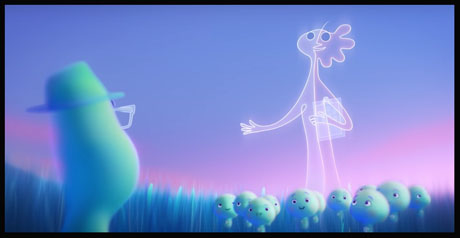
Michael Yates (Story Artist): During middle school, I played saxophone in band for a year. And it was a lot of pressure from my mom because she was this amazing clarinet player through high school. She had this tin of gold medals that she would collect and show me all the time. In the end, I was terrible at saxophone, and I felt like a failure… until working on this film, where I brought all those experiences back. All the kids goofing off was the only thing I really remembered about Band. It was fun to be able to put that into the movie.
JM: After years and years you realize, I am not a failure! I’m working on a Pixar movie!
MY: (laughs)
JM: You were able to design NYC pre-pandemic, sort of as it used to be. Did you have a sense of freedom in doing that?
MontaQue Ruffin (Animator): In design for performances I felt like I had a voice. It was so cool to be in a room with the animation team… and talking about what makes Joe feel authentic [and] what makes his culture and community feel authentic and familiar. Going on those research trips, seeing Jon Batiste come play live in front of us – all of that was really enjoyable and a treat.
JM: And what was your approach for the nightclubs – the jazz clubs of New York?
Jude Brownbill (Animation Supervisor): They needed to feel authentic. Pete and the story team… got to go to a lot of those clubs. We looked at a lot of references. We also have animators on our team from New York, so they got to tell us if we were getting it right as well.
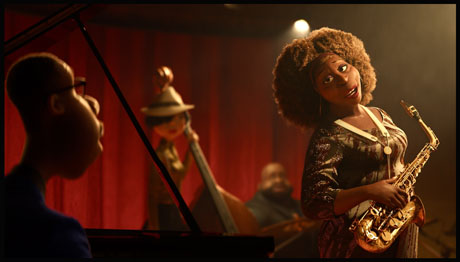
JM: So much of Pixar films is in the little details. Was getting the finger movements right one of the most difficult aspects, so people could say, ‘Yeah, this looks realistic’?
BP: I’m sure playing piano is very, very hard. Animating someone playing piano is a compounded level of difficulty. But we know there will be people… for that percentage [of the audience] who plays and that percentage who plays jazz, they’re gonna know we went the extra mile. We really did to hit the note, so to speak. They’ll appreciate it, and that’s important to us. If you’re gonna take your time to watch one of our films, we wanna make sure it’s valuable. That it’s worth it. That it’s got something that has meaning to it and depth to it. And this is the level of depth we’ll go to.
JM: We’ve been seeing in the commercials and trailers that Joe falls into a pothole. Why a pothole?
Aphton Corbin (Story Artist): That’s a great question because we tried killing him a bunch of different ways. We had to hit it just right where it was like, ‘Did he die?’ but also [it can’t be] too extreme. For some reason, the pothole felt a little bit on that safe, Looney Tunes land where it’s not too bad. And Pete really enjoyed the idea of falling through and landing somewhere else. That was the selling point. But there were a couple different versions.
Kristen Lester (Story Supervisor): Slipping on a patch of ice or tripping or something and he hit the back of his head. That was too graphic. A pole. There was a car. We also wanted it to specifically be a very New York way to go. In New York, you have those basements that open up that you don’t want to trip over and fall in. And everybody was like, ‘Ugh – it’s too real!’ So we ended-up with the pothole.
JM: There you go. And you don’t want it to be too serious and too violent because a PG-13 Pixar [movie] would probably not fly, at this point.
AC: Not yet!
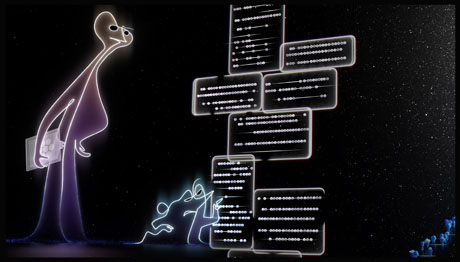
JM: Okay. That may be a tease! One of the most striking things I’ve seen in a Pixar movie in several years is the imagery of The Great Beyond and everybody on this conveyor belt.
JB: The slidewalk, as it was dubbed, was made to feel like there were a lot of souls on it and that there was a wide, diverse variety of them. We want people to look at Joe and his reaction to the new surroundings. And the intensity increases [throughout] the sequence. And Joe’s having to scramble his way through big crowds of people.
KL: Maybe it’s our own messed-up stairway to Heaven. We wanted Joe to come to realize that he had changed, be processing that, and all the while he was moving closer and closer to The Great Beyond. That meant that whatever he was on, it had to appear out of nothing. It had to be in motion while he was on it. We came-up with this idea of a slidewalk that revealed itself as he pieced together what had happened to him.
JM: With The Great Before, you’re creating rules. How was it coming up with everything for that?
MY: It was definitely a challenge, and it took years to figure it all out. Part of it was, ‘What’s the exposition that we need to get to the audience?’ And then over the process of screening it and watching it, you pull away certain things and then you start to add-in the entertainment. The Counselors were a big part of that – having these creatures that can do anything but making them fun and relatable. The two aspects that clicked for them the most were the ability to shape-shift… and the New Souls and treating it all like a playground where they’re learning as we’re learning as an audience.
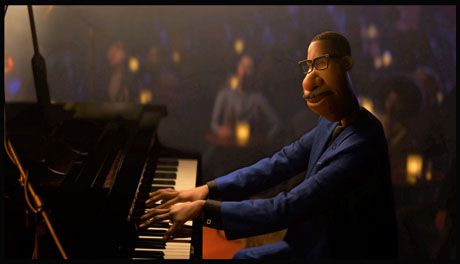
JM: Looking at the “exhibit of your life”: it’s dramatic, emotional and comedic at the same time. And it’s also surprising because you don’t expect to feel this way so soon into a film. How was it balancing the emotions when it comes to this sequence?
BP: This is the thing about… Pete Docter films. If you’ve seen Inside Out and Up. [In] Up, 10 minutes in, the whole theater’s a mess. This is not fair! The stories that he tells – he’s just trying to go to this emotional core and trust that instinct. One of the things that we all appreciate so much is being able to work with him and work with each other right now to create something that is pretty darn special. These are the moments we will talk about years from now. This film is of the time. It takes four or five years, but somehow it is of the time. And yet we also know that in 40 years it will be timeless. To be able to stop for a second and sit back and take that in, that’s an emotional thing.
JB: What I love about that sequence is that we’re looking, with Joe, at his own life. It also sort of makes you as a viewer think, ‘What if my life was laid-out in front of me and come to life? What would I put in my exhibit of my life?’ We’re still living and have a chance to affect that. Typical Pete: asking big questions and turning a mirror on us and asking questions about our own lives.
JM: You’re right. These are the moments Just like what [also] happened with Bing Bong in Inside Out. And there are a lot of elements for both kids and adults to think about.
AC: There were some trepidations from people, but we always wanted to stick with making the story first and finding ways to make the message sing – and we can find ways to make it entertaining and enjoyable as well. One of the things we were always surprised by is how smart kids are. We had an all-children’s screening, and the kids would totally understand it and be completely on board and understand it better than the adults would in the screening. But also some moments where we could have some good ol’ humor, not just for kids but for adults, too.
JM: Where would you say this ranks among the most ambitious stories that Pixar has ever done?
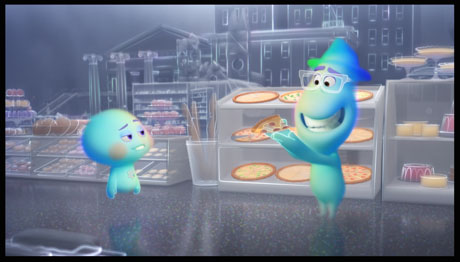
KL: When I came on board, I was like, ‘Okay – we’re doing this!’ It pushed my personal limits, my creative limits… how inventive could I be?’ And I don’t think I was the only one on the team who felt that way. We were all pushing really hard to make something new, fun and exciting – and moved people, all in the context of a world we’ve never been to and characters we’ve never seen. I would say it’s a very, very ambitious movie for sure.
JM: Soul has been delayed several months, but it’s been completed. So do you have a sense of satisfaction or relief now, or are you not going to be fully satisfied until people start seeing the movie?
AC: I don’t think I’ll be satisfied until people see it.
MY: We make it for people. It’s not just for our own enjoyment. There’s still that other piece of the puzzle that we’re waiting to fit in there.
KL: Definitely. We make these things to be seen. We make these things to be shared. And we’re not done until people have seen it and people have shared it with each other – and shared that experience.
BP: There’s a thing one of our supervising animators, Glenn McQueen, used to say years ago. He said, ‘These films are like having a present. And we know what’s in the box.’ There’s an excitement and maybe that satisfaction of when you’re giving something to someone just to be able to share it. It’s just around the corner.
- INTERVIEW: Jeff Fowler On “Knuckles” And “Sonic 3” - April 22, 2024
- INTERVIEW: “Inside Out 2” Director And Producer On Pixar Sequel - April 16, 2024
- INTERVIEW: “Puffin Rock And The New Friends” And 25 Years Of Cartoon Saloon - April 10, 2024


 December 15th, 2020
December 15th, 2020  Jackson Murphy
Jackson Murphy  Posted in
Posted in  Tags:
Tags: 






